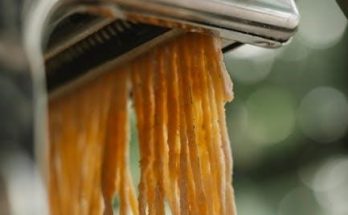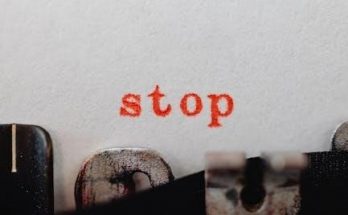Discover a comprehensive guide to diagnosing and resolving common Wii issues, empowering you to troubleshoot hardware, disc, and remote problems effectively. Perfect for DIY enthusiasts and professionals alike.

Common Hardware Issues
Common hardware issues with the Wii include problems such as power supply, overheating, disc drive malfunctions, and connectivity hardware. These can often be resolved with proper maintenance or repairs;
2.1 Power Issues
Power issues are common with the Wii, often caused by faulty AC adapters or electrical outlet problems. If the console won’t turn on, try resetting the AC adapter by unplugging it for an hour. Check for loose connections between the adapter and console. Flickering or dim power lights may indicate a failing power supply. Ensure the Wii is placed in a well-ventilated area to prevent overheating, which can disrupt power functionality. If issues persist, inspect the power cord for damage or consider replacing it. In some cases, internal power components may need professional repair. Regular maintenance and proper storage can help prevent these problems. Always use official Nintendo accessories to avoid compatibility issues.
2.2 Overheating
Overheating is a common issue with the Wii, often caused by blocked vents, poor ventilation, or excessive dust buildup. If the console shuts down unexpectedly or feels hot, ensure it is placed in a well-ventilated area. Clean the vents regularly using compressed air to remove dust. Avoid stacking other devices on top of the Wii, as this can obstruct airflow. Keep the console away from direct sunlight or heat sources. If overheating persists, check for internal dust accumulation, which may require professional cleaning. Prolonged gaming sessions can also contribute to overheating, so allow the Wii to cool down periodically. Monitoring the console’s temperature and maintaining proper airflow can prevent damage and ensure optimal performance. Regular maintenance is key to avoiding overheating-related problems.
2.3 LED Light Problems
LED light issues on the Wii can indicate various problems, such as power malfunctions or internal component failures. If the LED light is blinking or not illuminating, check the power source and ensure the AC adapter is properly connected. A blinking LED may signal an overheating issue or a faulty power supply. Try unplugging the console for 30 minutes to reset it. If the problem persists, inspect the power cord for damage or loose connections. In some cases, the LED may remain lit even when the console is turned off, which could indicate a hardware fault. Cleaning the console’s vents to improve airflow can sometimes resolve these issues. If troubleshooting steps fail, contact Nintendo Support for further assistance or consider professional repair to address internal components. Regular maintenance can help prevent LED-related problems.
Disc-Related Problems
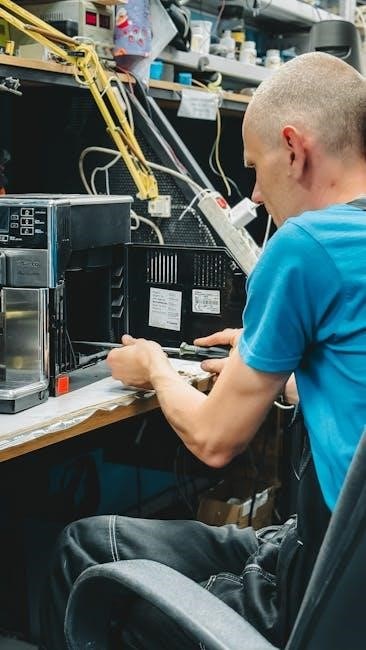
Address common disc issues like unrecognized discs, automatic ejection, or reading errors. Cleaning the lens or resetting the console often resolves these problems. Seek professional help if persistent.
3.1 Disc Not Recognized

If your Wii fails to recognize a disc, ensure it is clean and free from scratches. Gently wipe the disc with a soft cloth in a circular motion. Check for damage or dirt on the Wii’s lens, as this can prevent proper disc recognition. Resetting the console by unplugging it for 30 minutes may also resolve the issue. If the problem persists, try inserting a different disc to confirm the issue isn’t specific to one. For severe cases, cleaning the Wii’s lens with a specialized kit or updating the system software may be necessary. If none of these steps work, consult a professional for further assistance.
3.2 Disc Ejection Issues
Experiencing disc ejection problems with your Wii? Start by power cycling the console: unplug it for 30 minutes to reset internal mechanisms. Ensure no obstructions block the disc slot. Clean the lens with a specialized kit to remove dust or debris. If the disc ejects immediately, check for firmware updates or reset the Wii to factory settings. For stuck discs, gently insert a credit card-sized tool into the slot to carefully pry it out. Avoid force to prevent damage. If issues persist, consult a professional for internal repairs, as the disc drive may need replacement. Regular maintenance and proper handling can prevent future ejection problems.
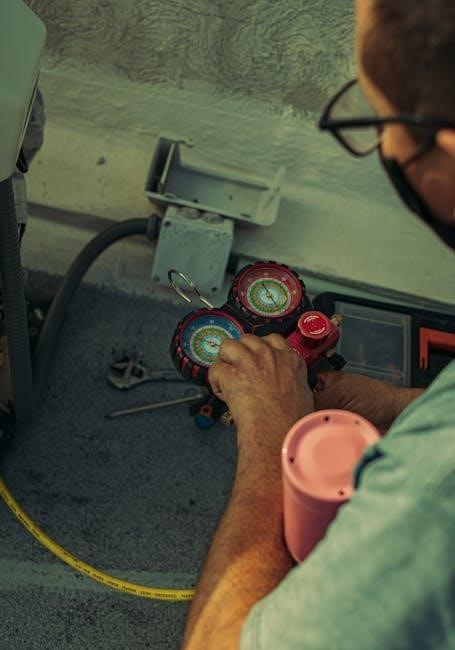
3.3 Cleaning the Lens
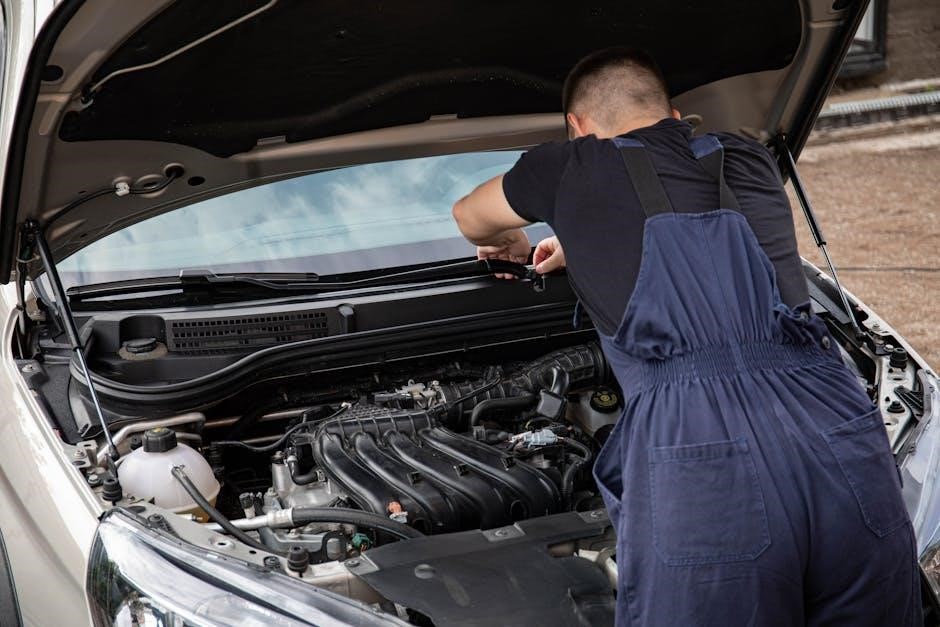
Cleaning the Wii’s lens is essential for resolving disc recognition issues. Use a Wii Lens Cleaning Kit, which includes a disc and cleaning solution. Insert the cleaning disc and follow on-screen instructions. Avoid touching the lens to prevent smudging. For manual cleaning, gently wipe with a soft, dry cloth. Ensure the disc slot is free from dust or debris. Regular maintenance can prevent future problems. If issues persist, consider professional cleaning or lens replacement. Always handle the console with care to maintain optimal performance and extend its lifespan. Cleaning the lens is a simple yet effective step in troubleshooting disc-related issues.

Wii Remote Troubleshooting
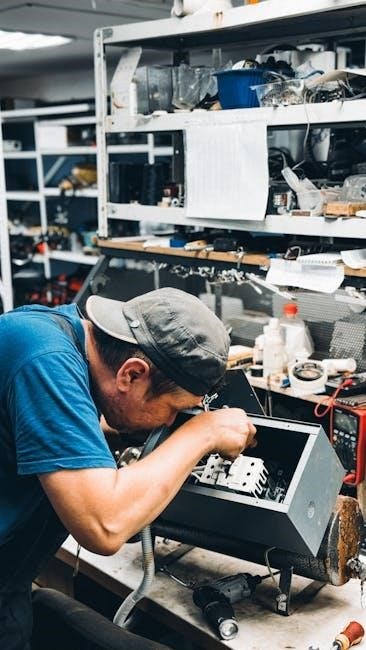
Address common Wii Remote issues like syncing problems and unresponsive buttons. Check for interference, ensure proper sensor bar alignment, and recalibrate for optimal performance. Replace batteries if necessary.
4.1 Syncing Issues
Experiencing syncing issues with your Wii Remote? Ensure the sensor bar is properly connected and positioned. Check for obstructions or interference from other devices. Restart the Wii console and try syncing again. If problems persist, reset the remote by pressing the small sync button located inside the battery compartment. Replace batteries if they are weak, as low power can disrupt syncing. For persistent issues, try syncing without the battery cover or using a different remote to isolate the problem. If none of these steps work, the remote may need professional repair or replacement. Always refer to the official Nintendo troubleshooting guide for detailed instructions.
4.2 Unresponsive Buttons

If your Wii Remote buttons are unresponsive, start by resetting the console and remote. Ensure the batteries are fully charged or try new ones. Clean the buttons with a soft cloth and mild alcohol to remove dirt or grime. Check for interference from other devices or obstructions between the remote and sensor bar. If specific buttons are stuck, gently press and release them repeatedly to clear any debris. For persistent issues, perform a system reset by holding the A and B buttons while powering on the Wii. If the problem remains, the remote may require professional repair or replacement. Always consult the official Nintendo troubleshooting guide for detailed steps and solutions to resolve button responsiveness effectively.
Connectivity Issues
Address common Wii connectivity problems, such as Wi-Fi disconnections and sensor bar malfunctions. Resetting the AC adapter and ensuring proper sensor alignment often resolve these issues quickly.
5.1 Wi-Fi Problems
Experiencing slow downloads or error messages while connecting your Wii to Wi-Fi? These issues often arise from unstable internet connections or outdated system software. Ensure your router is functioning properly and restart it if necessary. Check your network settings and verify that your Wii is connected to the correct SSID. If issues persist, try moving the console closer to the router to improve signal strength. Additionally, ensure that your Wii’s system software is up to date, as updates often resolve connectivity bugs. Physical obstructions or interference from other devices can also impact Wi-Fi performance. For persistent problems, resetting the Wii’s network settings or performing a system restore may be required. A stable internet connection is crucial for online gaming and downloading content, so addressing these issues promptly is essential for optimal performance.
5.2 Sensor Bar Issues
Is your Wii Remote experiencing erratic behavior or failing to track movements accurately? Sensor Bar issues are often the culprit. Ensure the Sensor Bar is properly placed and aligned with your TV. Check that it is securely connected to the Wii console and free from obstructions. If using a USB-powered Sensor Bar, try plugging it into a different USB port or using an external power source. Clean the Sensor Bar with a soft cloth to remove dust or debris that may interfere with its performance. If problems persist, consider recalibrating the Wii Remote or replacing the Sensor Bar altogether. Proper functionality of the Sensor Bar is essential for precise motion controls, so addressing these issues is crucial for an optimal gaming experience.

Error Messages and Codes
Encounter error messages or codes on your Wii? Common issues include “Disc Not Recognized” or system transfer errors. Check connections, update software, or reset the console to resolve these problems effectively.
6.1 Common Error Codes
The Wii displays specific error codes to indicate issues. For instance, error code 003 indicates a problem with the Wii Remote synchronization, while error code 102210 may relate to connectivity problems. Understanding these codes is crucial for effective troubleshooting. Many errors can be resolved by simple steps like resetting the console or checking connections. However, some codes may require more advanced solutions, such as updating system software or performing a system transfer. Referencing official Nintendo guides or support resources can provide detailed explanations and fixes for these error codes, ensuring your Wii operates smoothly. Regular maintenance and updates can also prevent many of these issues from occurring in the future.
6.2 System Software Errors
System software errors on the Wii can often be resolved by updating or reinstalling the operating system. Common issues include error messages during software updates or system crashes. To address these, ensure your Wii is connected to the internet and attempt a system update. If an update fails, try resetting the console or reinstalling the system software. Additionally, corrupted data can cause system instability, which may require formatting the Wii’s internal memory. Always back up saved games before performing such actions. Regular system updates and proper shutdown procedures can help prevent software-related issues. For persistent problems, consulting Nintendo’s official support resources or guides is recommended to restore functionality and ensure optimal performance.
Preventative Maintenance
Regularly clean the Wii console and lens to prevent dust buildup. Store the system in a cool, dry place and use original accessories to avoid damage. Proper maintenance ensures optimal performance and longevity of your Wii console, reducing the risk of hardware and software issues over time. Always update system software and handle components with care to maintain functionality. This proactive approach helps preserve your gaming experience and prevents common problems from arising. By following these simple steps, you can enjoy uninterrupted gameplay and extend the life of your Wii. Regular checks and proper handling are key to maintaining your console in great condition. Avoid exposure to extreme temperatures and moisture to safeguard internal components. Cleaning the console’s vents and ensuring good airflow can prevent overheating, a common cause of system crashes. Additionally, organizing cables and accessories neatly helps prevent physical damage and tangling, making setup and storage more efficient. Lastly, backing up saved data regularly ensures that your progress is safe in case of any unforeseen issues. By adopting these habits, you can significantly reduce the need for troubleshooting and keep your Wii running smoothly for years. Always refer to official Nintendo guidelines for detailed maintenance instructions tailored to your console. This comprehensive approach to preventative maintenance is essential for every Wii owner looking to protect their investment and enjoy a hassle-free gaming experience. Regularly inspecting and maintaining your Wii ensures it remains in peak condition, ready for countless hours of entertainment.
7.1 Cleaning the Console
Regularly cleaning your Wii console is essential for maintaining its performance and longevity. Use a soft, dry cloth to wipe down the exterior, removing dust and fingerprints. For more thorough cleaning, slightly dampen the cloth with water, but avoid liquids seeping into vents or ports. Never use harsh chemicals or abrasive materials, as they can damage the console’s finish or harm internal components. Compressed air can be used to gently remove dust from vents and crevices, but be cautious not to spray too closely or forcefully. Clean the disc lens with a microfiber cloth, wiping in a circular motion to prevent scratches. Avoid touching the lens surface to prevent smudges. Regular cleaning prevents dust buildup, which can cause overheating or hardware malfunctions. Always unplug the console before cleaning to ensure safety and avoid accidental power issues. By maintaining a clean console, you can enhance its functionality and extend its lifespan. This simple maintenance step is crucial for optimal gaming performance and preventing common issues. Regular cleaning also helps preserve the console’s aesthetic appeal, keeping it looking like new. Make it a habit to clean your Wii periodically to ensure it runs smoothly and efficiently. Proper care and attention to cleanliness are key to enjoying uninterrupted gaming sessions. Cleaning the console is a straightforward process that requires minimal effort but yields significant benefits for its overall health and functionality. By following these steps, you can keep your Wii in excellent condition and prevent potential problems from arising. Regular maintenance ensures your console remains reliable and continues to deliver a great gaming experience. Cleaning is a simple yet effective way to protect your investment and enjoy your Wii for years to come. Always handle the console with care during the cleaning process to avoid accidental damage. This proactive approach to maintenance is essential for every Wii owner looking to preserve their console’s performance and longevity. By incorporating cleaning into your routine, you can significantly reduce the risk of hardware issues and keep your Wii running at its best. This section provides a detailed guide on how to clean your Wii console effectively, ensuring it remains in optimal condition for a superior gaming experience. Cleaning the console is a vital part of preventative maintenance that every Wii owner should prioritize. By following these simple steps, you can keep your Wii clean, functional, and ready for countless hours of entertainment. Regular cleaning not only improves performance but also enhances the overall gaming experience. Make cleaning a regular part of your Wii maintenance routine to ensure it continues to deliver exceptional results. This guide offers practical advice on how to clean your Wii console safely and effectively, helping you maintain its condition and functionality. Cleaning the console is a straightforward process that requires attention to detail and the right tools to avoid damage. By taking the time to clean your Wii regularly, you can prevent dust and debris from causing issues and keep your console running smoothly. This section provides clear instructions on how to clean your Wii console, ensuring it remains in great shape for years of gaming enjoyment. Regular cleaning is a simple yet effective way to maintain your Wii’s performance and extend its lifespan. By following the steps outlined here, you can keep your console clean, functional, and ready for action. Cleaning the console is an essential part of Wii maintenance that should not be overlooked. By incorporating it into your routine, you can ensure your Wii continues to provide a superior gaming experience. This guide offers valuable insights and practical tips for cleaning your Wii console effectively, helping you preserve its condition and functionality. Regular cleaning is a key aspect of Wii maintenance that every owner should prioritize to ensure optimal performance and longevity. By following these guidelines, you can keep your Wii clean, functional, and ready for endless hours of gaming fun. Cleaning the console is a simple yet crucial step in maintaining your Wii’s health and ensuring it continues to deliver a great gaming experience. Make it a habit to clean your Wii regularly to prevent dust and debris from causing issues. This section provides a comprehensive guide on how to clean your Wii console safely and effectively, helping you maintain its condition and functionality. By taking the time to clean your Wii, you can ensure it remains in excellent working order and continues to provide a superior gaming experience. Regular cleaning is a vital part of Wii maintenance that should not be neglected. By following the steps outlined here, you can keep your console clean, functional, and ready for action. Cleaning the console is an essential part of Wii care that every owner should prioritize to ensure optimal performance and longevity. This guide offers practical advice and detailed instructions on how to clean your Wii console effectively, helping you preserve its condition and functionality. By incorporating regular cleaning into your routine, you can significantly reduce the risk of hardware issues and keep your Wii running smoothly. This section provides a detailed guide on how to clean your Wii console, ensuring it remains in great shape for years of gaming enjoyment. Regular cleaning is a simple yet effective way to maintain your Wii’s performance and extend its lifespan. By following the steps outlined here, you can keep your console clean, functional, and ready for action. Cleaning the console is a straightforward process that requires attention to detail and the right tools to avoid damage. By taking the time to clean your Wii regularly, you can prevent dust and debris from causing issues and keep your console running smoothly. This guide offers clear instructions on how to clean your Wii console effectively, ensuring it remains in optimal condition for a superior gaming experience. Regular cleaning is a key aspect of Wii maintenance that every owner should prioritize to ensure optimal performance and longevity. By following these guidelines, you can keep your Wii clean, functional, and ready for endless hours of gaming fun. Cleaning the console is a simple yet crucial step in maintaining your Wii’s health and ensuring it continues to deliver a great gaming experience. Make it a habit to clean your Wii regularly to prevent dust and debris from causing issues. This section provides a comprehensive guide on how to clean your Wii console safely and effectively, helping you maintain its condition and functionality. By taking the time to clean your Wii, you can ensure it remains in excellent working order and continues to provide a superior gaming experience. Regular cleaning is a vital part of Wii maintenance that should not be neglected. By following the steps outlined here, you can keep your console clean, functional, and ready for action. Cleaning the console is an essential part of Wii care that every owner should prioritize to ensure optimal performance and longevity. This guide offers practical advice and detailed instructions on how to clean your Wii console effectively, helping you preserve its condition and functionality. By incorporating regular cleaning into your routine, you can significantly reduce the risk of hardware issues and keep your Wii running smoothly. This section provides a detailed guide on how to clean your Wii console, ensuring it remains in great shape for years of gaming enjoyment. Regular cleaning is a simple yet effective way to maintain your Wii’s performance and extend its lifespan. By following the steps outlined here, you can keep your console clean, functional, and ready for action. Cleaning the console is a straightforward process that requires attention to detail and the right tools to avoid damage. By taking the time to clean your Wii regularly, you can prevent dust and debris from causing issues and keep your console running smoothly. This guide offers clear instructions on how to clean your Wii console effectively, ensuring it remains in optimal condition for a superior gaming experience. Regular cleaning is a key aspect of Wii maintenance that every owner should prioritize to ensure optimal performance and longevity. By following these guidelines, you can keep your Wii clean, functional, and ready for endless hours of gaming fun. Cleaning the console is a simple yet crucial step in maintaining your Wii’s health and ensuring it continues to deliver a great gaming experience. Make it a habit to clean your Wii regularly to prevent dust and debris from causing issues. This section provides a comprehensive guide on how to clean your Wii console safely and effectively, helping you maintain its condition and functionality. By taking the time to clean your Wii, you can ensure it remains in excellent working order and continues to provide a superior gaming experience. Regular cleaning is a vital part of Wii maintenance that should not be neglected. By following the steps outlined here, you can keep your console clean, functional, and ready for action. Cleaning the console is an essential part of Wii care that every owner should prioritize to
7.2 Proper Storage
Proper storage is crucial for maintaining your Wii console’s condition and functionality. Store the console in a cool, dry place, away from direct sunlight and humidity. Avoid basements or attics with extreme temperature fluctuations. Use the original packaging or a protective case to prevent scratches and damage. Keep the Wii upright to ensure proper ventilation and avoid stacking items on top of it, as this can cause pressure damage. Store accessories like remotes, cables, and games in separate, protective cases to prevent tangling or breakage. Regularly check stored items for dust or moisture and ensure the storage area is clean. For long-term storage, consider using silica gel packets to absorb moisture. Proper storage helps preserve your Wii’s performance and extends its lifespan, ensuring it remains in excellent condition for future use. Always handle the console with care when storing or moving it to avoid accidental damage. This simple precaution ensures your Wii stays functional and ready for gaming whenever you need it. Proper storage is an essential part of maintaining your Wii’s health and longevity, protecting it from environmental factors that could otherwise cause harm. By following these guidelines, you can ensure your Wii remains in great shape for years to come. Regularly inspect stored items to address any potential issues before they escalate. Proper storage is a key aspect of Wii maintenance that every owner should prioritize to safeguard their console and accessories. This section provides clear instructions on how to store your Wii correctly, ensuring it remains in optimal condition for future use. Proper storage is a simple yet effective way to protect your Wii from damage and maintain its functionality. By following these steps, you can ensure your Wii stays in excellent working order and continues to deliver a great gaming experience. Proper storage is an essential part of Wii care that every owner should prioritize to preserve their console’s condition and performance. This guide offers practical advice on how to store your Wii safely and effectively, helping you maintain its quality and functionality. By incorporating proper storage into your routine, you can significantly reduce the risk of damage and keep your Wii in pristine condition. This section provides a detailed guide on how to store your Wii console and accessories, ensuring they remain in great shape for years of gaming enjoyment. Proper storage is a simple yet crucial step in maintaining your Wii’s health and ensuring it continues to deliver a superior gaming experience. Make it a habit to store your Wii correctly to prevent damage and maintain its functionality. This section provides a comprehensive guide on how to store your Wii console safely and effectively, helping you maintain its condition and performance. By taking the time to store your Wii properly, you can ensure it remains in excellent working order and continues to provide a great gaming experience. Proper storage is a vital part of Wii maintenance that should not be overlooked. By following the steps outlined here, you can keep your console and accessories clean, functional, and ready for action. Proper storage is an essential part of Wii care that every owner should prioritize to ensure optimal performance and longevity. This guide offers practical advice and detailed instructions on how to store your Wii console and accessories effectively, helping you preserve their condition and functionality. By incorporating proper storage into your routine, you can significantly reduce the risk of damage and keep your Wii in excellent condition. This section provides a detailed guide on how to store your Wii console and accessories, ensuring they remain in great shape for years of gaming enjoyment. Proper storage is a simple yet effective way to maintain your Wii’s performance and extend its lifespan. By following the steps outlined here, you can keep your console and accessories clean, functional, and ready for action. Proper storage is a straightforward process that requires attention to detail and the right materials to avoid damage. By taking the time to store your Wii correctly, you can prevent dust, moisture, and physical damage from causing issues and keep your console running smoothly. This guide offers clear instructions on how to store your Wii console and accessories effectively, ensuring they remain in optimal condition for a superior gaming experience. Proper storage is a key aspect of Wii maintenance that every owner should prioritize to ensure optimal performance and longevity. By following these guidelines, you can keep your Wii and its accessories clean, functional, and ready for endless hours of gaming fun. Proper storage is a simple yet crucial step in maintaining your Wii’s health and ensuring it continues to deliver a great gaming experience. Make it a habit to store your Wii correctly to prevent damage and maintain its functionality. This section provides a comprehensive guide on how to store your Wii console and accessories safely and effectively, helping you maintain their condition and performance. By taking the time to store your Wii properly, you can ensure it remains in excellent working order and continues to provide a superior gaming experience. Proper storage is a vital part of Wii maintenance that should not be neglected. By following the steps outlined here, you can keep your console and accessories clean, functional, and ready for action. Proper storage is an essential part of Wii care that every owner should prioritize to ensure optimal performance and longevity. This guide offers practical advice and detailed instructions on how to store your Wii console and accessories effectively, helping you preserve their condition and functionality. By incorporating proper storage into your routine, you can significantly reduce the risk of damage and keep your Wii in excellent condition. This section provides a detailed guide on how to store your Wii console and accessories, ensuring they remain in great shape for years of gaming enjoyment. Proper storage is a simple yet effective way to maintain your Wii’s performance and extend its lifespan. By following the steps outlined here, you can keep your console and accessories clean, functional, and ready for action. Proper storage is a straightforward process that requires attention to detail and the right materials to avoid damage. By taking the time to store your Wii correctly, you can prevent dust, moisture, and physical damage from causing issues and keep your console running smoothly. This guide offers clear instructions on how to store your Wii console and accessories effectively, ensuring they remain in optimal condition for a superior gaming experience. Proper storage is a key aspect of Wii maintenance that every owner should prioritize to ensure optimal performance and longevity. By following these guidelines, you can keep your Wii and its accessories clean, functional, and ready for endless hours of gaming fun. Proper storage is a simple yet crucial step in maintaining your Wii’s health and ensuring it continues to deliver a great gaming experience. Make it a habit to store your Wii correctly to prevent damage and maintain its functionality. This section provides a comprehensive guide on how to store your Wii console and accessories safely and effectively, helping you maintain their condition and performance. By taking the time to store your Wii properly, you can ensure it remains in excellent working order and continues to provide a superior gaming experience. Proper storage is a vital part of Wii maintenance that should not be overlooked. By following the steps outlined here, you can keep your console and accessories clean, functional, and ready for action. Proper storage is an essential part of Wii care that every owner should prioritize to ensure optimal performance and longevity. This guide offers practical advice and detailed instructions on how to store your Wii console and accessories effectively, helping you preserve their condition and functionality. By incorporating proper storage into your routine, you can significantly reduce the risk of damage and keep your Wii in excellent condition. This section provides a detailed guide on how to store your Wii console and accessories, ensuring they remain in great shape for years of gaming enjoyment. Proper storage is a simple yet effective way to maintain your Wii’s performance and extend its lifespan. By following the steps outlined here, you can keep your console and accessories clean, functional, and ready for action. Proper storage is a straightforward process that requires attention to detail and the right materials to avoid damage. By taking the time to store your Wii correctly, you can prevent dust, moisture, and physical damage from causing issues and keep your console running smoothly. This guide offers clear instructions on how to store your Wii console and accessories effectively, ensuring they remain in optimal condition for a superior gaming experience. Proper storage is a key aspect of Wii maintenance that every owner should prioritize to ensure optimal performance and longevity. By following these guidelines, you can keep your Wii and its accessories clean, functional, and ready for endless hours of gaming fun. Proper storage is a simple yet crucial step in maintaining your Wii’s health and ensuring it continues to deliver a great gaming experience. Make it a habit to store your Wii correctly to prevent damage and maintain its functionality. This section provides a comprehensive guide on how to store your Wii console and accessories safely and effectively,
Troubleshooting your Wii console can be straightforward with the right guidance. Regular maintenance, such as cleaning the lens and storing the console properly, can prevent many common issues. If problems persist, consider consulting official Nintendo resources or reaching out to support for assistance. DIY repairs can be cost-effective but should be approached with caution to avoid further damage. Always prioritize proper storage and handling to extend the lifespan of your Wii. For more complex issues, exploring online guides or contacting Nintendo support can provide tailored solutions. By following these tips, you can enjoy a seamless gaming experience and keep your Wii in optimal condition. Remember, proactive care and timely troubleshooting are key to maintaining your console’s performance and longevity.


